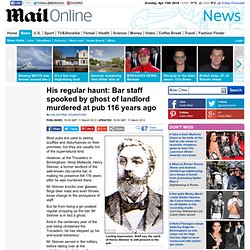

Just what the doctor hoarded! Medic finds Civil War coins worth £51,000 buried in his garden... and hands them to a museum. Dr Owen Johnson also found a gold ring bearing the inscription: 'When you see this, remember me'Treasure laws mean the 600-coin hoard belongs to the state By Mark Lister Published: 15:10 GMT, 28 March 2012 | Updated: 12:20 GMT, 3 April 2012 As he explored his own back garden, a scrap of pottery protruding from the dirt caught Dr Owen Johnson's eye.

When the hospital worker tried to dig it out, it cracked open - spilling out a stream of gold and silver coins 'like a slot machine'. Dr Johnson, 53, was inspecting a hole dug by builders at his home, in the village of High Ackworth, near Pontefract, West Yorkshire. Token of love: The gold ring found among the hoard bears the romantic inscription 'When you see this, remember me' The haul of Civil War currency could be worth as much as £51,000 - but the doctor has had to hand it all in to the Government. 'It was then we started to realise this was something significant.
Britain's bravest family awarded record breaking three Victoria Cross Medals in just two generations. By Suzannah Hills Published: 04:18 GMT, 28 March 2012 | Updated: 10:45 GMT, 28 March 2012 Highest honour: Charles Gough was the first of three people in his family to be awarded the Victoria Cross for numerous acts of bravery A family has been named the most courageous in Britain after being awarded a record breaking three Victoria Cross Medals for acts of bravery in battle.

Evocative lost paintings of polar explorer who sketched Captain Scott's doomed expedition emerge after 100 years. Paintings' re-emergence coincides with planned auction of other expedition memorabilia, including Scott's last letter By Rachel Rickard Straus Published: 13:12 GMT, 22 March 2012 | Updated: 20:35 GMT, 22 March 2012 The evocative ‘lost’ paintings produced by a polar explorer who later perished alongside Captain Scott on his doomed expedition to the South Pole have emerged 100 years on.

25 Brutal Historical Methods of Execution. The US remains one of the few countries in the world that still engages in capital punishment. Historically, however, it was widely used in a wide variety of ways that are sure to make you uncomfortable if you pause to think about it too long. Charles Dickens film from 111-years ago found after going missing for half a century. Film made in 1901, 31 years after Dickens' deathThought to have been inspired by Dickens' novel Bleak House By Rachel Rickard Straus.

Day the Exeter mail coach was held up by a LION 200 years ago. By Rob Cooper Published: 08:29 GMT, 16 March 2012 | Updated: 10:54 GMT, 16 March 2012 These days the occasional vicious dog is the only obstacle postal workers face when doing their rounds.

But almost 200 years ago mailmen were attacked by a lion as they travelled through the English countryside in an extraordinary incident. Despite the terrified workers fleeing for their lives as the Exeter Mail Coach was ambushed by an escaped circus beast, the post still arrived at its final destination just 45 minutes late. Mauling: A lion attacks one of the horses on the Exeter to London mail coach as it travels through Wiltshire almost 200 years ago. A lost painting of the long-forgotten attack has come to light and is due to go under the hammer at auction later this month. Very cold case: 2,000-year-old murder is solved as CT scan reveals Iron Age man was bludgeoned, strangled, then beheaded in a human sacrifice. By Rob Waugh Published: 10:48 GMT, 9 March 2012 | Updated: 12:13 GMT, 9 March 2012 Archaeologists have solved a 1900-year-old 'cold case' mystery - using a medical CT scanner to scan the head of an Iron Age murder victim.

The preserved head of the second century Briton - known as The Worsley Man due to his location near Salford - was found in a peat bog in 1958. The scan shows he as bludgeoned over the head, garrotted and then beheaded - leading archaeologists to suspect he was sacrificed. A CT scan of the Iron Age 'Worsley Man' has shown that he was bludgeoned over the head, strangled, then beheaded - and the level of violence has led archaeologists to speculate that it may have been a pagan ritual Experts had been divided over how he died - but the new CT scan shows clear marks of the ligature that strangled him. The Worsley Man is thought to have lived around 100AD when Romans occupied much of Britain. His head has been kept at the Manchester Museum on Oxford Road since its discovery. Prehistoric skeletons and a Roman wall found at London 2012 Olympic site.
Bar staff spooked by ghost of landlord murdered at pub 116 years ago. By Valentina Jovanovski Published: 19:39 GMT, 11 March 2012 | Updated: 19:39 GMT, 11 March 2012 Lasting impression: Staff say the spirit of Henry Skinner is still present at the pub Most pubs are used to seeing scuffles and disturbances on their premises, but they are usually not of the supernatural kind.

However, at the Trocadero in Birmingham, West Midlands, Henry Skinner, a former landlord of the well-known city-centre bar, is making his presence felt 116 years after he was murdered there. Mr Skinner knocks over glasses, flings beer mats and even throws loose change to the annoyance of staff. But far from being a gin-soaked regular propping up the bar, Mr Skinner is in fact a ghost. Is legend of St Patrick just a bit of blarney? He was a runaway tax collector turned slave trader, says expert. By David Wilkes Published: 00:02 GMT, 17 March 2012 | Updated: 10:24 GMT, 17 March 2012 No saint: The legend of St Patrick, the Patron Saint of Ireland, isn't what it seems, an expert says Legend has it St Patrick came to Ireland in the fifth century to spread the word of Christ – and banish snakes from its shores.

But as St Patrick's Day is celebrated today, it seems the patron saint's motives for leaving Roman Britain may have been less selfless than previously thought. Researchers claim that St Patrick actually fled to Ireland to avoid becoming a tax collector. Patrick's father was a Decurion, a Roman official responsible for tax collection in Britain. Dr Roy Flechner, an expert in ancient and medieval history from Cambridge University, claims that Patrick, alarmed at the prospect of taking on the unpopular job, decided to emigrate.
As well as collecting tax (with any shortfall coming from the Decurion's own pocket), duties included road maintenance and the recruitment of soldiers. Anglo Saxon grave reveals 16-year-old girl laid to rest with a gold cross. By Tamara Cohen Published: 00:03 GMT, 16 March 2012 | Updated: 07:55 GMT, 16 March 2012 Laid to rest in her best clothes and lying on an ornamental bed, she was probably of noble blood.

Quite how the 16-year-old Anglo Saxon girl died and who she was remain a mystery.